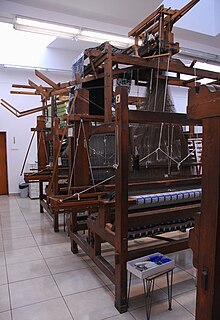Jacquard weaving
From Wikipedia, the free encyclopedia
Jacquard weaving makes possible in almost any loom the programmed raising of eachwarp thread independently of the others. This brings much greater versatility to the weavingprocess, and offers the highest level of warp yarn control. This mechanism is probably one of the most important weaving inventions as Jacquard shedding made possible the automatic production of unlimited varieties of pattern weaving. The term "Jacquard" is not specific or limited to any particular loom, but rather refers to the added control mechanism that automates the patterning.
Contents[hide] |
[edit]History
In former times if figured designs were required, this was done on a drawloom. The heddleswith warp ends to be pulled up were manually selected by a second operator (draw boy), apart from the weaver. It was slow and labour intensive, with practical limitations on the complexity of the pattern.
The first important improvement of the draw loom took place in 1725, when Basile Bouchonintroduced the principal of applying a perforated band of paper. A continuous roll of paper was punched by hand, in sections, each of which represented one lash or tread, and the length of the roll was determined by the number of shots in each repeat of pattern. The Jacquard machine subsequently evolved from this.
The Jacquard process and the necessary loom attachment are named after their inventor,Joseph Marie Jacquard (1752–1834). He recognized that although weaving was intricate, it was repetitive, and saw that a mechanism could be developed for the production of sophisticated patterns just as it had been done for the production of simple patterns.
It is difficult to determine what part of the 'Jacquard' machine, Jacquard himself designed. He may have combined the best mechanical elements of other inventors, but at any rate the machine he made must have differed from its predecessors in arrangement and minor working details. It was similar in most general principles to Vaucanson's arrangement, except that he made use of Jean-Baptiste Falcon's individual paste board cards and his square prism or card 'cylinder', which he is credited with having fully perforated on each of its four sides in lieu of Vaucanson's perforated 'barrel'. Jacquard's machine also contained eight rows of needles and uprights as compared with Vaucanson's double row, which modifications enabled him to increase the figuring capacity of the machine. In his first machine he supported the harness by knotted cords, which he elevated by a single trap board.
One of the chief advantages which was claimed for the Jacquard machine was that, previously in weaving damasks the figuring shed was usually drawn once for every four shots, with the new apparatus it could be drawn on every shot, thus producing a fabric with greater definition of outline.[1]
Jacquard's invention had a deep influence on Charles Babbage. In that respect, he is viewed by some authors as a precursor of modern computing science.[2]
[edit]Mechanical Jacquard looms
Originally the Jacquard machines were mechanical, and the fabric design was stored in a series of punched cards which were joined together to form a continuous chain. The Jacquards often were small and only independently controlled a relatively few warp ends. This required a number of repeats across the loom width. Larger capacity machines, or the use of multiple machines, allowed greater control, with fewer repeats, and hence larger designs to be woven across the loom width.
A factory must choose looms and shedding mechanisms to suit its commercial requirements. As a rule the more warp control required the greater the expense. So it is not economical to purchase Jacquard machines if one can make do with a dobby mechanism. As well as the capital expense, the Jacquard machines are more costly to maintain, as they are complex and require higher skilled personnel; an expensive design system is required to prepare the designs for the loom, and possibly a card-cutting machine. Weaving is more costly since Jacquard mechanisms are more liable to produce faults than dobby or cam shedding. Also, the looms will not run as fast and down time will increase as it takes time to change the continuous chain of cards when a design changes. For these reasons it is best to weave larger batch sizes with mechanical Jacquards.
[edit]Electronic Jacquard looms
Bonas Machine Company Ltd.[3] launched the first electronic Jacquard at ITMA,[4] Milan in 1983. Although the machines were initially small, modern technology has allowed Jacquard machine capacity to increase significantly, and single end warp control can extend to more than 10,000 warp ends. This avoids the need for repeats and symmetrical designs and allows almost infinite versatility. The computer-controlled machines significantly reduce the down time associated with changing punched paper designs, thus allowing smaller batch sizes. However, electronic Jacquards are costly and may not be required in a factory weaving large batch sizes, and smaller designs. The larger machines allowing single end warp control are very expensive, and can only be justified where great versatility is required, or very specialized design requirements need to be met. For example, they are an ideal tool to increase the ability and stretch the versatility of the niche linen Jacquard weavers who remain active in Europe and the West, while most of the large batch commodity weaving has moved to low cost areas.
Linen products associated with Jacquard weaving are linen damask napery, Jacquard apparel fabrics and damask bed linen.
Jacquard weaving of course uses all sorts of fibers and blends of fibers, and it is used in the production of fabrics for many end uses. Research is under way to develop layered and shaped items as reinforcing components for structures made from composite materials.










No comments:
Post a Comment